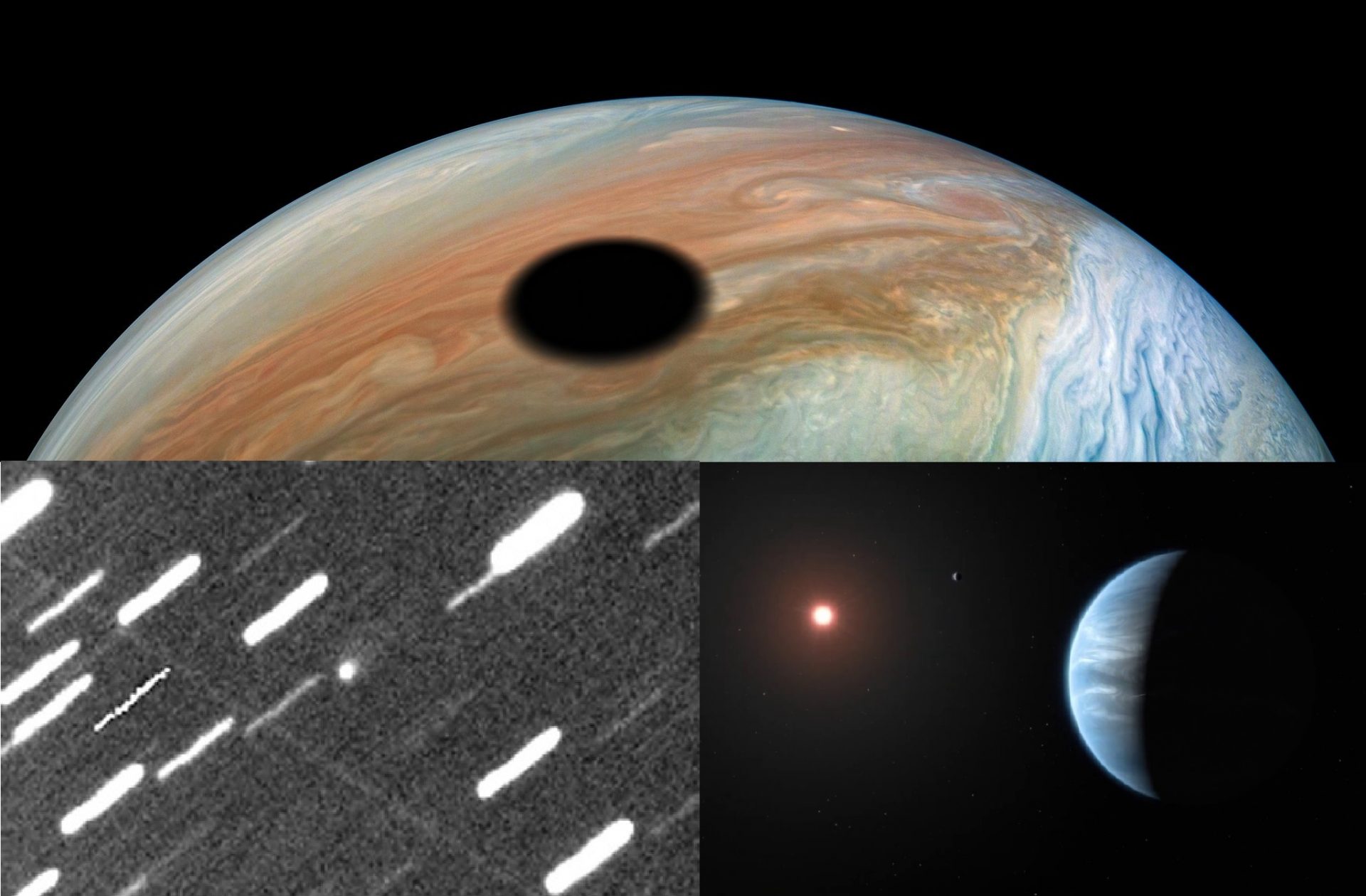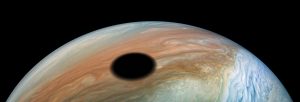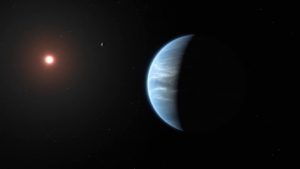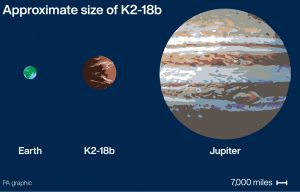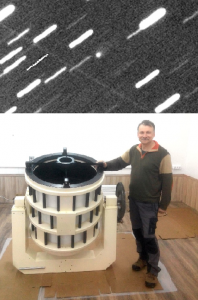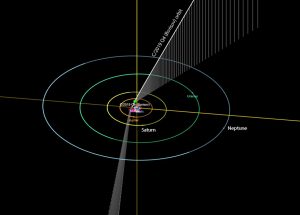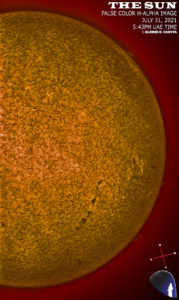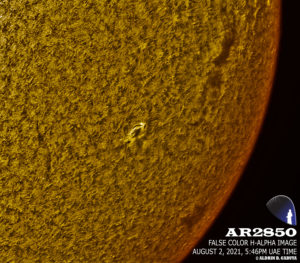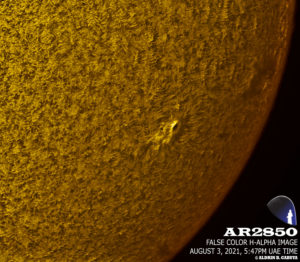Io eclipse on Jupiter witnessed by NASA’s Juno mission
Lady luck was on the side of NASA’s Juno spacecraft when Jupiter’s volcanic moon Io skirted between the Sun and the gas giant last September 11.
In its 22nd skim over the largest planet in the Solar System, the spacecraft was able to take various snaps of Io’s massive shadow cast over the Jupiter’s surface.
Io is one of Jupiter’s four large moons and also the one closest to the planet. It is considered as the most volcanic cosmic object in our Solar System, precisely because of the heat generated by Jupiter’s massive gravity.
The raw images of the Juno mission, such as this recent eclipse, are always uploaded online. More often than not, there are “volunteer image processors” who would work into these data to produce images that mimic photographs taken from space of eclipses on Earth.
Water on exoplanet found. Can it be a “habitable” planet?
In an unprecedented discovery, researchers have found pieces of evidence that there is water in an exoplanet from a star system far, far away—the exoplanet K2-18b.
K2-18b was first spotted in 2015 via NASA’s Kepler spacecraft through transit method, but the presence of water has only been confirmed this month by two separate researches published in arXiv and in the peer-reviewed journal Nature Astronomy.
But it’s not really water, per se. It’s water vapor and likely liquid water clouds in the atmosphere. Still, it caused waves in the astronomy community, as it could be a potential “habitable” planet located in the Leo constellation—which is about 110 light-years from Earth.
The papers used the same data gleaned by the Hubble Telescope and are released publicly online.
With water present in this exoplanet, could it be a potential second home?
Well, according to scientists, it’s a bit complicated. In fact, there had been quite a debate on this in the following days after the news was announced.
The Nature Astronomy paper considered it a “Super-Earth.” This exoplanet is about eight times the mass of our home planet and is situated in the habitable zone of a star system known as the Goldilocks zone, or the best region where it’s not too near or too far from its star that water can exist.
However, several scientists argue that K2-18b is a “Mini-Neptune,” with a deep atmosphere of hydrogen and/or helium, and possibly no solid surface at all—making it not “habitable.”
In the end, the potentiality ofK2-18b as a habitable planet can be summed up in writer Paul Scott Anderson’s words in his Earth Sky article:
“Finding evidence for water vapor on a distant exoplanet in its star’s habitable zone is exciting, but is not in itself proof of habitability,” Anderson said. “There are many factors that need to be considered, including the composition of the planet and its atmosphere.”
Interstellar comet visits Solar System
Two years after the momentous visit of ‘Oumuamua in 2017, astronomers have detected a second interstellar object passing by our Solar System—the Comet C/2019 Q4 (Borisov).
A Ukrainian amateur astronomer named Gennady Borisov first caught a glimpse of the comet last August 30 using a 0.65-meter telescope he built all by himself. The comet is now named after Borisov, who also works as an engineer at the Sternberg Astronomical Institute in Ukraine.
Concrete astrometry analysis by the Minor Planet Center and NASA Horizons JPL suggests thatC/2019 Q4 (Borisov) may have originated outside the Solar System.
The comet was examined by its orbital eccentricity or the measurement of how much an elliptical orbit is “squashed”, and its hyperbolic orbit—the “trajectory of any object around a central body with more than enough speed to escape the central object’s gravitational pull,” as explained by Rocket and Space Technology.
They found out that C/2019 Q4 (Borisov) has a high eccentricity of 3.2 and possessed an extremely fast velocity—roughly 41 kilometers per second.
Moreover, two separate short researches from the Jagellonian University in Poland and the Instituto de Astrofisica de Canarias in Spain both found out that Comet C/2019 Q4 (Borisov)’s composition is essentially similar to that of long-period comets originated from the Oort cloud, which is greenish-white “dirty snowballs”, containing ice and dust.
The Oort cloud is often touted as the “home of the comets,” and it is the most distant region of our solar system, according to NASA.
Comet C/2019 Q4 (Borisov)is generally faint, with an apparent magnitude of around +18, and can only be observed through long-exposure acquisition using large telescopes.
It can be tough observing this newfound gem in the sky, since it can only be found at low elevation before dawn. The best time to observe this comet, though, is from December 8 until 10, when it is at perihelion or its closest approach to the Sun.
Astronomers, both professional and amateur, are expected to be all eyes on the interstellar visitor in the coming months, in hopes of finding out more of its origin and its features.
Al Sadeem captures two comets in the September sky
Meanwhile, Al Sadeem Astronomy has captured images of two comets in the past week. These are the recently discovered Comet C/2018 W2 (Africano) and the Comet C/2018 N2 (ASASSN).
Comet C/2018 W2 Africano was near perihelion at magnitude 12.48 when it was imaged by the observatory for over two hours, while Comet C/2018 N2 (ASASSN) that was captured with an apparent magnitude of +12.82, is expected to reach perihelion in November.
REFERENCES
- https://www.space.com/juno-sees-io-moon-shadow-on-jupiter.html
- https://twitter.com/kevinmgill/status/1173741101515079680?ref_src=twsrc%5Etfw%7Ctwcamp%5Etweetembed%7Ctwterm%5E1173741101515079680&ref_url=https%3A%2F%2Fdigg.com%2F2019%2Fjupiter-io-shadow-solar-eclipse
- https://www.space.com/alien-planet-k2-18b-water-vapor-not-earth-twin.html
- https://earthsky.org/space/water-vapor-potentially-habitable-exoplanet-super-earth-k2-18b
- https://solarsystem.nasa.gov/asteroids-comets-and-meteors/comets/oumuamua/in-depth/
- https://solarsystem.nasa.gov/solar-system/oort-cloud/overview/
- https://phys.org/news/2019-09-potentially-habitable-planet.html
- https://phys.org/news/2019-09-astronomers-potentially-habitable-exoplanet.html
- https://www.sciencealert.com/here-s-what-we-know-so-far-about-possibly-interstellar-comet-c-2019-q4-borisov
- https://www.skyandtelescope.com/astronomy-news/possible-interstellar-comet-headed-our-way/

